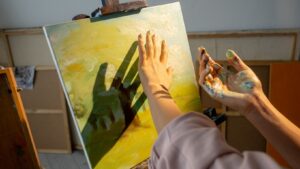Stepping into a world where creativity knows no bounds, I’ve always been captivated by the concept of living art. From vibrant botanical installations to mesmerizing human canvases, the fusion of nature and expression never fails to inspire. In this article, I delve into the enchanting realm of living art, exploring how artists breathe life into their creations and blur the lines between art and reality.
Immersing myself in the intricate details of living sculptures and interactive exhibits, I’ve witnessed firsthand the power of art to transcend traditional boundaries. Whether it’s the graceful movements of a living statue or the harmonious blend of colors in a botanical masterpiece, each piece tells a unique story that resonates with viewers on a profound level.
Living Art
Defining Living Art
Living art, in its essence, is the fusion of nature and artistic expression to craft enchanting installations and exhibitions that breathe life into spaces. It’s a form of art that intertwines the natural world with creative ingenuity, blurring the lines between traditional art forms and organic elements. In living art, artists harness the vitality of living organisms such as plants, flowers, and even animals to create immersive and dynamic art pieces that evolve over time. This innovative approach to art transforms static creations into living masterpieces that continuously grow, change, and interact with their environment.

Historical Context and Evolution
The roots of living art can be traced back to ancient civilizations that revered nature and incorporated it into their artistic endeavors. Throughout history, cultures around the world have embraced the concept of living art, using plants, flowers, and living elements to beautify sacred spaces, celebrate festivals, and honor the natural world. Over time, living art has evolved from simple floral arrangements to intricate living sculptures and immersive installations that challenge conventional notions of art and beauty.
As artists continue to push the boundaries of creativity, living art has gained recognition as a unique and dynamic form of artistic expression. By harnessing the transformative power of nature, artists are redefining the traditional art landscape and inviting audiences to experience art in a truly organic and evolving way. The evolution of living art mirrors our deep-rooted connection to the natural world, inviting us to contemplate the beauty, fragility, and resilience of life through immersive and captivating art experiences.
Forms of Living Art
Performance Art as Living Art

Performance art, one of the captivating forms of living art, entails creating dynamic pieces that come to life through actions and movements. It blurs the lines between artist and artwork, often incorporating elements of unpredictability and audience interaction. As an artist, I appreciate how performance art allows me to express emotions and ideas in a visceral and immediate manner, connecting with viewers on a personal level. This form of living art thrives on the ephemeral nature of the human experience, making each performance a unique and unrepeatable masterpiece.
Bio Art: The Intersection of Biology and Art
Bio art represents a fascinating fusion of scientific exploration and artistic expression within the realm of living art. By manipulating living organisms and biotechnologies, artists like myself create thought-provoking pieces that challenge societal perceptions of life and nature. Working in this field, I am constantly amazed by the boundless creative possibilities that arise from integrating biology into art. Bio art serves as a testament to the intricate interconnectedness of all living beings, prompting viewers to contemplate the delicate balance between humanity and the natural world.
Interactive Installations: Engaging the Spectator
Interactive installations redefine the spectator’s role in experiencing living art, transforming passive observers into active participants. These installations, designed to provoke engagement and exploration, invite viewers to immerse themselves in the artistic environment. Personally, I find immense joy in crafting interactive pieces that elicit emotional responses and spark meaningful interactions among spectators. Through these installations, I aim to break down barriers between art and audience, fostering a sense of connection and collaboration that transcends traditional artistic boundaries.
